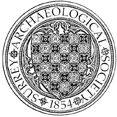Reigate Priory
Observation by D W Williams of the digging of floodlight cable trenches south of the standing buildings revealed a number of general levels: featureless brown sandy loam below possibly 16th/l7th century layers below a possible 18th century courtyard surface, itself below a spread of late 19th century stone and brick rubble. At three points adjacent to the sunken garden were observed the substantial footings of stone walls bonded with yellow mortar.


